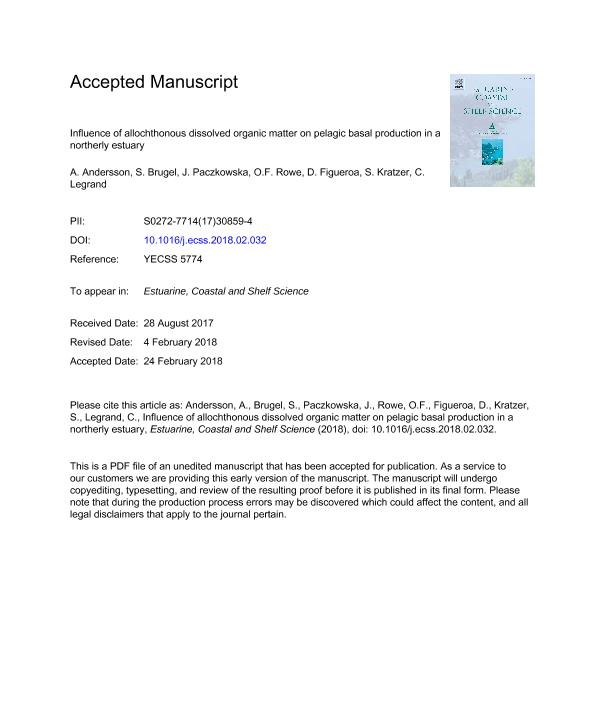Artículo
Influence of allochthonous dissolved organic matter on pelagic basal production in a northerly estuary
Andersson, Agneta; Brugel, S.; Paczkowska, Joanna Marianna ; Rowe, O.F.; Figueroa, D.; Kratzer, S.; Legrand, C.
; Rowe, O.F.; Figueroa, D.; Kratzer, S.; Legrand, C.
 ; Rowe, O.F.; Figueroa, D.; Kratzer, S.; Legrand, C.
; Rowe, O.F.; Figueroa, D.; Kratzer, S.; Legrand, C.
Fecha de publicación:
05/2018
Editorial:
Academic Press Ltd - Elsevier Science Ltd
Revista:
Estuarine, Coastal and Shelf Science
ISSN:
0272-7714
Idioma:
Inglés
Tipo de recurso:
Artículo publicado
Clasificación temática:
Resumen
Phytoplankton and heterotrophic bacteria are key groups at the base of aquatic food webs. In estuaries receiving riverine water with a high content of coloured allochthonous dissolved organic matter (ADOM), phytoplankton primary production may be reduced, while bacterial production is favoured. We tested this hypothesis by performing a field study in a northerly estuary receiving nutrient-poor, ADOM-rich riverine water, and analyzing results using multivariate statistics. Throughout the productive season, and especially during the spring river flush, the production and growth rate of heterotrophic bacteria were stimulated by the riverine inflow of dissolved organic carbon (DOC). In contrast, primary production and photosynthetic efficiency (i.e. phytoplankton growth rate) were negatively affected by DOC. Primary production related positively to phosphorus, which is the limiting nutrient in the area. In the upper estuary where DOC concentrations were the highest, the heterotrophic bacterial production constituted almost 100% of the basal production (sum of primary and bacterial production) during spring, while during summer the primary and bacterial production were approximately equal. Our study shows that riverine DOC had a strong negative influence on coastal phytoplankton production, likely due to light attenuation. On the other hand DOC showed a positive influence on bacterial production since it represents a supplementary food source. Thus, in boreal regions where climate change will cause increased river inflow to coastal waters, the balance between phytoplankton and bacterial production is likely to be changed, favouring bacteria. The pelagic food web structure and overall productivity will in turn be altered.
Archivos asociados
Licencia
Identificadores
Colecciones
Articulos(CESIMAR)
Articulos de CENTRO PARA EL ESTUDIO DE SISTEMAS MARINOS
Articulos de CENTRO PARA EL ESTUDIO DE SISTEMAS MARINOS
Citación
Andersson, Agneta; Brugel, S.; Paczkowska, Joanna Marianna; Rowe, O.F.; Figueroa, D.; et al.; Influence of allochthonous dissolved organic matter on pelagic basal production in a northerly estuary; Academic Press Ltd - Elsevier Science Ltd; Estuarine, Coastal and Shelf Science; 204; 5-2018; 225-235
Compartir
Altmétricas



